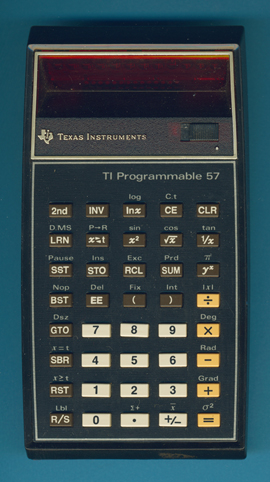
DATAMATH CALCULATOR MUSEUM
 |
DATAMATH CALCULATOR MUSEUM |
Texas Instruments TI Programmable 57
| Date of introduction: | May 24, 1977 | Display technology: | LED-stick |
| New price: | $79.95, £49.95 $40.00 (October 1981) |
Display size: | 8 + 2 |
| Size: | 5.8" x 3.1" x
1.4" 148 x 78 x 36 mm3 |
||
| Weight: | 6.4 ounces, 180 grams | Serial No: | 1246799 |
| Batteries: | BP6, BP7 | Date of manufacture: | wk 32 year 1977 |
| AC-Adapter: | AC9131, AC9132 | Origin of manufacture: | USA |
| Precision: | 11 | Integrated circuits: | TMC1501 |
| Logic: | AOS - 4 Pending Operations, 9 () | ||
| Memories: | 8 | ||
| Program steps: | 50 | Courtesy of: | Joerg Woerner |
| Download leaflet: | |
Download manual: | |

![]() Introduced
together with the TI-58 and TI-59
the TI-57 represented the low budget programmable calculator of that epoch and
replaced the SR-56.
Unbelievable that this powerful calculator made use of the one-chip approach of
the SR-40 calculator.
Introduced
together with the TI-58 and TI-59
the TI-57 represented the low budget programmable calculator of that epoch and
replaced the SR-56.
Unbelievable that this powerful calculator made use of the one-chip approach of
the SR-40 calculator.

 A sales brochure of 1977 says:
"The key to its value is a remarkable advance in integrated circuit
technology - a single MOS/LSI chip with the equivalent capacity of 30,000
transistors". Well, today the guys at TI integrate millions and millions of
transistors on one chip.
A sales brochure of 1977 says:
"The key to its value is a remarkable advance in integrated circuit
technology - a single MOS/LSI chip with the equivalent capacity of 30,000
transistors". Well, today the guys at TI integrate millions and millions of
transistors on one chip.
A novel step was the squeezing of key entries into program
code, the time before the memory hold the key codes. This technique allowed up
to 3 key entries, i.e. [INV] [2nd] [sin] to be compressed into one program step. Sure
that marketing sold a calculator with 50 memory positions as a calculator with 150
program steps!
Please read this interesting comment from Anders Persson: "However, it was actually possible to pack up to four keystrokes in one step, not only three. An instruction like [INV] [2nd] [Prd] [4] would still fit in one step (code -39 4). Admittedly, not many instructions took four keystrokes - perhaps this is the only one...".
If you are interested in the calculating accuracy of scientific calculators don't miss the Calculator forensics.

 Texas
Instruments changed early in production (around September 1977 or wk 36 year 1977) the
battery pack and the related connector and charger from the SR-51-II
style to the TI-55 style.
Texas
Instruments changed early in production (around September 1977 or wk 36 year 1977) the
battery pack and the related connector and charger from the SR-51-II
style to the TI-55 style.



 While
the BP6 battery pack used with the original design of the TI-57 holds just two
AA-sized NiCd batteries in its case, includes the BP7 battery pack used with the
revised design of the TI-57 not only the two NiCd batteries but also a small
printed circuit board (PCB) with step-up DC/DC converter to generate the 9
Volts power supply of the calculator electronics.
While
the BP6 battery pack used with the original design of the TI-57 holds just two
AA-sized NiCd batteries in its case, includes the BP7 battery pack used with the
revised design of the TI-57 not only the two NiCd batteries but also a small
printed circuit board (PCB) with step-up DC/DC converter to generate the 9
Volts power supply of the calculator electronics.
The battery packs are not
compatible, don't use a BP6 with a AC9132
charger!
Simply by comparing the designation of the integrated circuits of the upper line "Majestic" calculators, you'll get the all members of this family:
| • TMC1501 TI-57 • TMC1502 MBA • TMC1503 TI-55 |
 Later in production the metallized TI logo was replaced with
an un-metalized. This gives in total 3 different US versions. View here the TI-57
w/o chrome. Finally we should add an early TI-57
assembled in Italy with different styling.
Later in production the metallized TI logo was replaced with
an un-metalized. This gives in total 3 different US versions. View here the TI-57
w/o chrome. Finally we should add an early TI-57
assembled in Italy with different styling.
The TI-57 was sold under the label of Radio Shack as EC-4000
and in Hungary as Híradástechnika
PTK-1050.
The calculator was available till 1982.
Find a nice collection of program listings for the TI-57 on Laurent's website.
| TI Programmable 57
The self-teaching programming system for student and professionals. Eight multi-use memories provide addressable memory locations to store and recall data. Powerful program memory stores 50 fully merged steps (up to 150 key-strokes). Once a program is built, it can be executed repeatedly by supplying new sets of variables. Computer-like programming functions help solve repetitive problems quickly and accurately. © Texas Instruments, 1981 |
If you have additions to the above article please email: joerg@datamath.org.
© Joerg Woerner, December 5, 2001. No reprints without written permission.